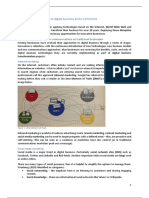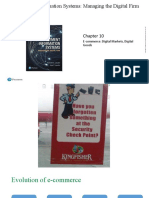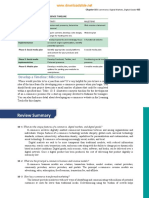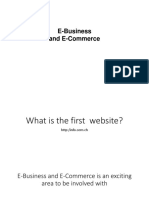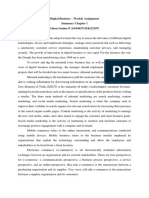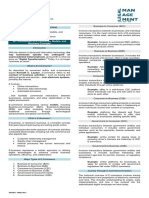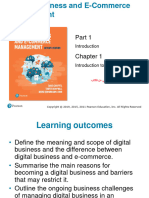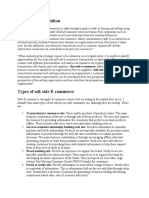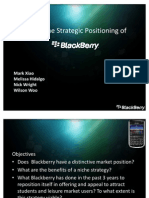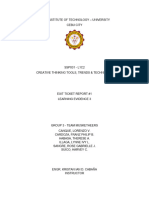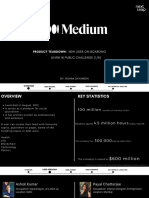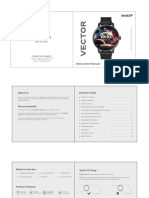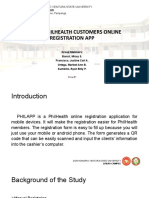Questions and Answers
• Inbound Marketing Q: What is inbound marketing and why is it important? A: Inbound marketing is
a strategy where customers initiate contact by seeking information, primarily online. It relies on
attracting potential customers rather than pushing messages to them. This 'pull' approach reduces
advertising wastage and focuses on visibility in search engines for relevant terms. Known as the Zero
Moment of Truth (ZMOT), inbound marketing combines search marketing, content marketing, and
social media marketing to proactively engage prospects. Marketers have less direct control
compared to traditional 'push' marketing, but experts like Dharmesh Shah and Brian Halligan
highlight its effectiveness in generating qualified leads, increasing engagement, and fostering long-
term customer relationships through valuable content.
• Social Media Marketing Q: What is social media marketing? A: Social media marketing leverages
the rapid growth of social networks such as Facebook, Twitter, LinkedIn, Google+, and niche
platforms to promote products, services, and brands. It includes engaging content on blogs, virtual
worlds, and specialized media sites. Rich media, including videos and interactive applications, plays a
key role. Social media marketing enables two-way communication, helps understand customer
preferences, builds communities, enhances brand awareness, and encourages sharing and
recommendations among users.
• Mobile Commerce Q: Explain mobile commerce and its significance. A: Mobile commerce (m-
commerce) involves conducting commercial transactions through mobile devices such as
smartphones and tablets. Usage is dominated by apps from iOS, Android, and Windows platforms,
with users spending the majority of their mobile time in apps rather than browsers. Location-based
services allow for personalized shopping experiences and tracking of goods during supply chain
processes. Analysts like Mary Meeker forecasted mobile usage surpassing desktop usage globally,
emphasizing the growing significance of mobile devices in digital business, customer engagement,
and marketing strategies.
• E-commerce Defined Q: Define e-commerce and its scope. A: E-commerce refers to all electronically
mediated transactions between an organization and third parties, including pre-sale, sale, and post-
sale interactions. It encompasses communications, business process automation, services, and
online buying/selling. Buy-side e-commerce focuses on procurement from suppliers, while sell-side
e-commerce focuses on selling to customers. Social commerce, incorporating reviews, ratings, group
buying, and connections to social networks, enhances customer engagement, improves
understanding of needs, and increases sales conversions.
• Digital Business Defined Q: What is digital business? A: Digital business is a broader concept than
e-commerce, focusing on transforming key business processes using digital technologies. It includes
research and development, marketing, manufacturing, inbound and outbound logistics, and both
buy-side and sell-side e-commerce transactions. Digital business integrates technology to streamline
processes, enhance service delivery, reduce costs, and create new value propositions for customers
and partners.
1
�• Intranets and Extranets Q: Define intranet and extranet. A: An intranet is a private network
accessible only to employees, often including enterprise social media tools to enhance collaboration
and information sharing. An extranet extends access to specific external partners, suppliers, or
customers for controlled collaboration. Examples include Shell SIMON for suppliers and Dell Premier
extranet for customer services.
• Types of Sell-side E-commerce Q: What are the types of sell-side e-commerce? A: Five main types
exist:
• Transactional sites: Enable online purchases and support offline buying.
• Services-oriented sites: Build relationships, provide information, and generate leads.
• Brand-building sites: Focus on enhancing brand experience, typically for FMCG products.
• Publisher/media sites: Deliver news, information, or entertainment and generate revenue through
ads or commissions.
• Social network sites: Influence company-customer interactions, facilitate engagement, and are often
ad-supported.
• Options to Reach Audience Online Q: Explain owned, earned, and paid media. A:
• Paid media: Advertisements bought via search engines, display networks, affiliate marketing, and
traditional media (TV, print, direct mail).
• Earned media: Publicity generated through PR, social sharing, influencer engagement, and word-of-
mouth.
• Owned media: Digital assets controlled by the company such as websites, blogs, email lists, apps,
and social media profiles, which allow direct engagement with audiences.
• Digital Marketing Q: What is digital marketing? A: Digital marketing applies digital channels and
technologies—web, email, databases, mobile, digital TV—to acquire and retain customers. It
emphasizes a multichannel approach, understanding the customer lifecycle, leveraging customer
data for targeted communications, and improving engagement through personalized, relevant
content. Strategic planning ensures alignment with organizational goals, maximizing ROI and
customer loyalty.
• Digital Media Channels Q: What are key digital media channels? A: Digital media channels facilitate
brand awareness, engagement, and conversion:
• Pay-per-click (PPC): Paid text ads appearing in search engine results.
• Search Engine Optimization (SEO): Improves organic search rankings for target keywords.
• Online PR: Enhances brand reputation through third-party mentions and engagement.
• Online partnerships: Collaborations, affiliate marketing, co-branding, and link-building.
• Interactive advertising: Banners, rich media ads, and other interactive formats.
• Opt-in email marketing: Engages customers for activation and retention.
• Social media marketing: Builds customer relationships and encourages conversation on social
platforms.
2
�• Digital Business Infrastructure Q: What is digital business infrastructure and associated risks? A:
Infrastructure includes hardware (servers, client devices), networks, software, architecture, and
methods for publishing and sharing data. Risks involve network failures, hardware/software
malfunctions, and data quality issues, which can disrupt customer, partner, and internal operations.
Proper management ensures reliability, security, performance, and continuous availability of digital
services.
• Infrastructure Management Issues Q: List key management issues in digital infrastructure. A: Key
issues include:
• Selecting supported digital access platforms (mobile, tablets, APIs).
• Setup and configuration of new digital services (hosting, cloud, domain selection).
• Ensuring quality of service (security, speed, uptime, error reduction).
• Decisions on internal vs. external hosting.
• Integrating applications with legacy and partner systems.
• Content and data quality management for accurate, timely information.
• Controlling employee internet access to prevent misuse.
• Securing data against accidental or malicious loss.
• Five-Level Infrastructure Model (Kampas 2000) Q: Describe the five-level infrastructure model. A:
• Storage/physical: Memory and disk hardware.
• Processing: Computation and logical operations.
• Infrastructure: Human interfaces, networks, and external connections ('extrastructure').
• Application/content: Processing data into usable information.
• Intelligence: Advanced logic that transforms information into knowledge.
• Uniform Resource Locators (URLs) Q: What is a URL? A: A URL is a standardized web address that
enables locating domains or specific documents, similar to a postal address. Businesses must
implement consistent URL strategies to organize resources, facilitate navigation, and support
marketing campaigns effectively.
• Online Marketplace Terms Q: Define key terms: Online marketplace, Path to purchase,
Multiscreening, Destination site, Online intermediaries. A:
• Online marketplace: Platforms enabling transactions and information exchange between
consumers, businesses, and governments.
• Path to purchase: The sequence of sites, channels, devices, and information sources consumers use
to make purchase decisions.
• Multiscreening: Using multiple devices simultaneously, such as TV and tablet.
• Destination site: Retailer or manufacturer site providing sales and service information.
• Online intermediaries: Sites that connect users with destination sites, including search engines,
comparison sites, and media publishers.
3
�• Situation Analysis Q: What is situation analysis and environmental scanning? A: Situation analysis
involves collecting and reviewing internal and external information to inform strategic decisions.
Environmental scanning continuously monitors market, competitor, and technology changes to
identify opportunities and threats, shaping marketing, business, and IT strategies.
• Online Marketplace Map Elements Q: What are the main elements of online marketplace analysis?
A:
• Customer segments: Identify and understand target segments' behavior, online media consumption,
and content preferences.
• Search intermediaries: Analyze major search engines per market, use tools like Google Trends, and
monitor search term shares.
• Intermediaries, influencers, media sites: Evaluate mainstream media, social networks, niche sites,
price comparison, affiliates, and bloggers for partnership and visibility.
• Destination sites: Assess sites intended for visitors, evaluate Online Value Proposition (OVP), and
compare with competitors to optimize user experience.
• Marketplace Channel Structures Q: Explain channel structures and disintermediation. A:
Distribution channels involve manufacturers delivering products via intermediaries like wholesalers
and retailers. The Internet enables disintermediation, bypassing intermediaries to sell directly,
saving costs and potentially lowering prices for customers. Examples include artists selling music
directly to consumers online.
• Reintermediation Q: What is reintermediation? A: After disintermediation, new intermediaries
emerge to support consumer decisions, e.g., MoneySupermarket.com or Opodo. E-commerce
managers must ensure product presence on these platforms, integrate pricing databases, monitor
competitor pricing, and may establish proprietary intermediaries to enhance market positioning.
• Portal Q: Define portal. A: A portal is a website acting as a gateway to information and services,
providing search, directories, personalized news, or email functionalities.
• Online Business Model Q: Define an










